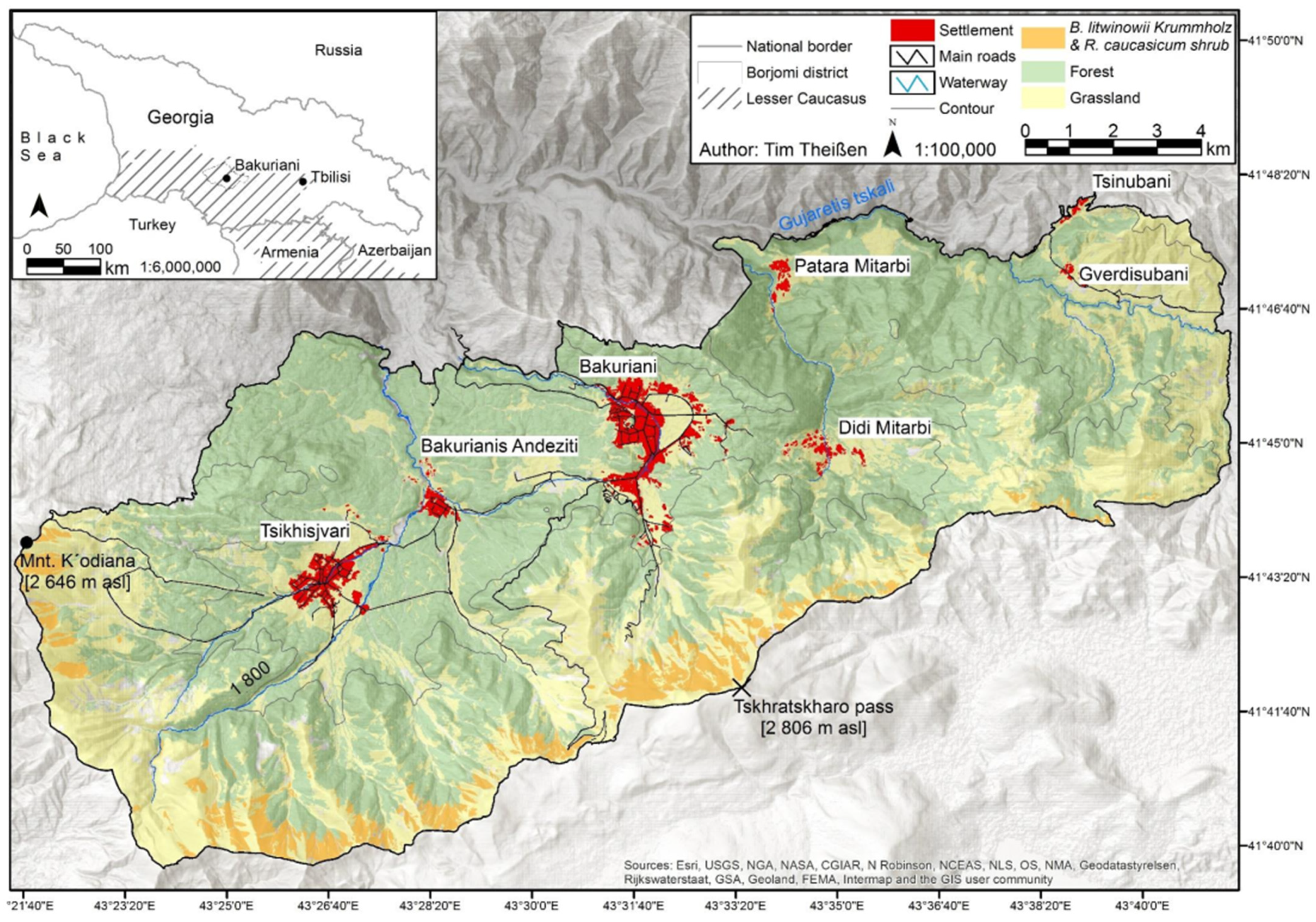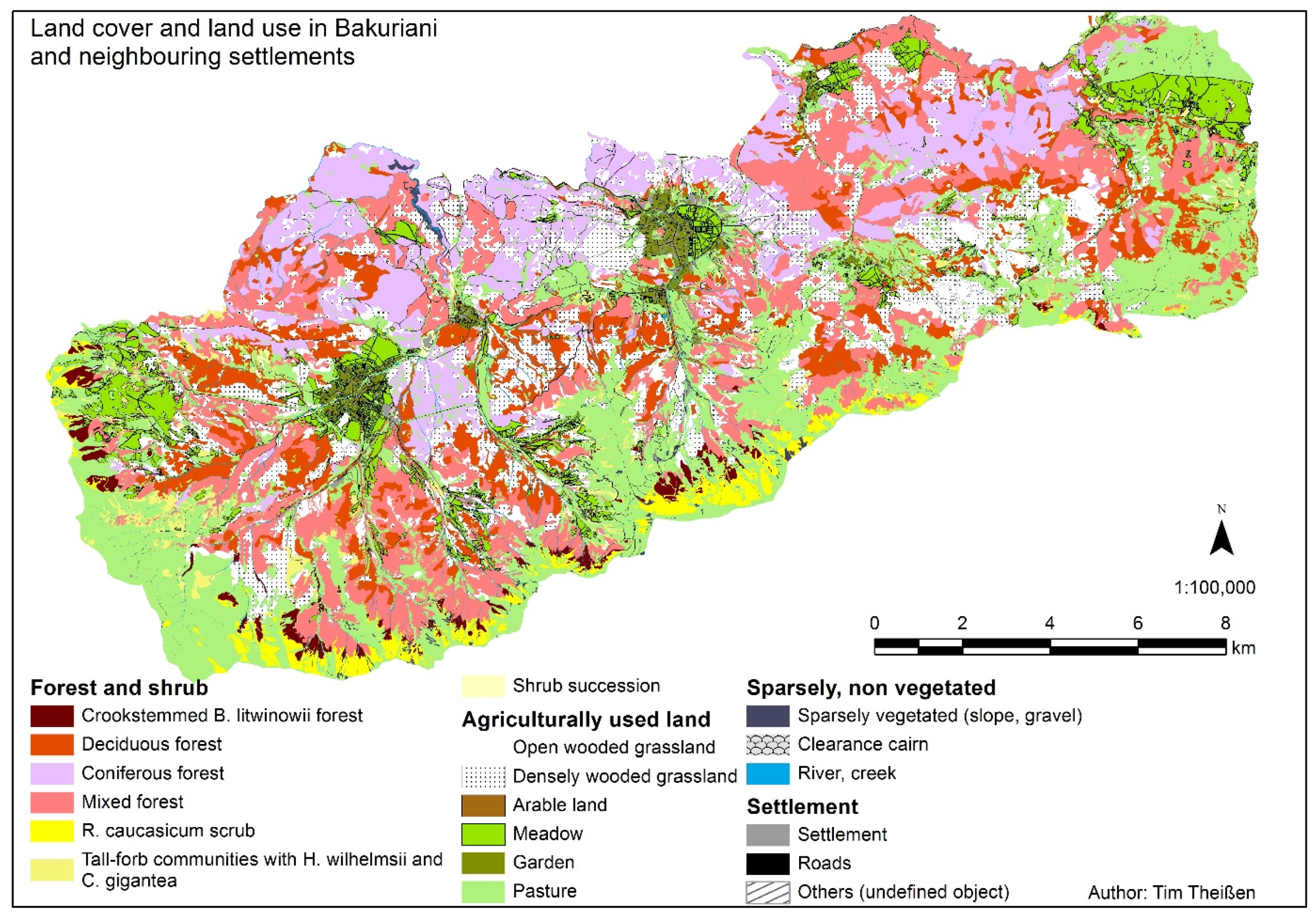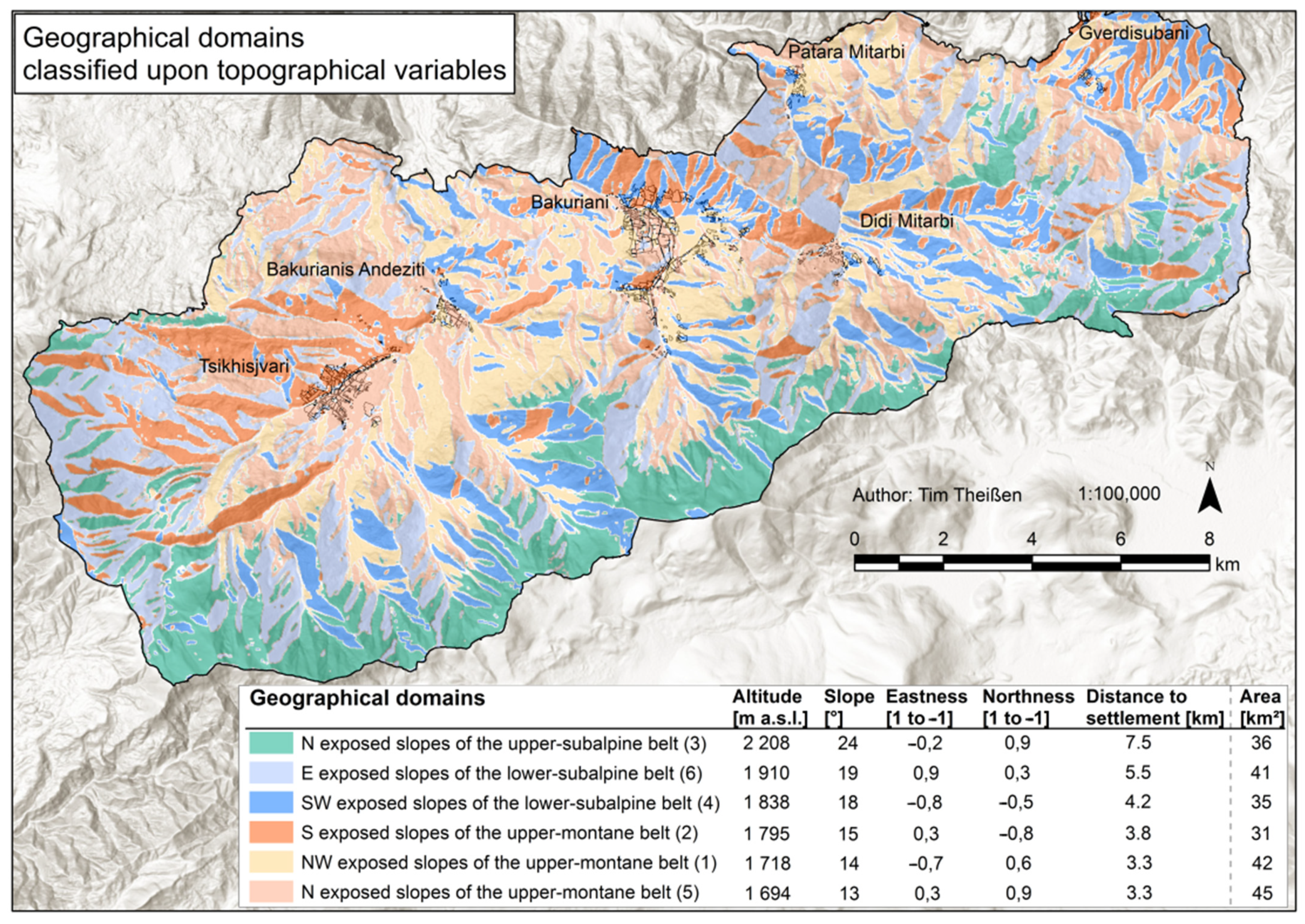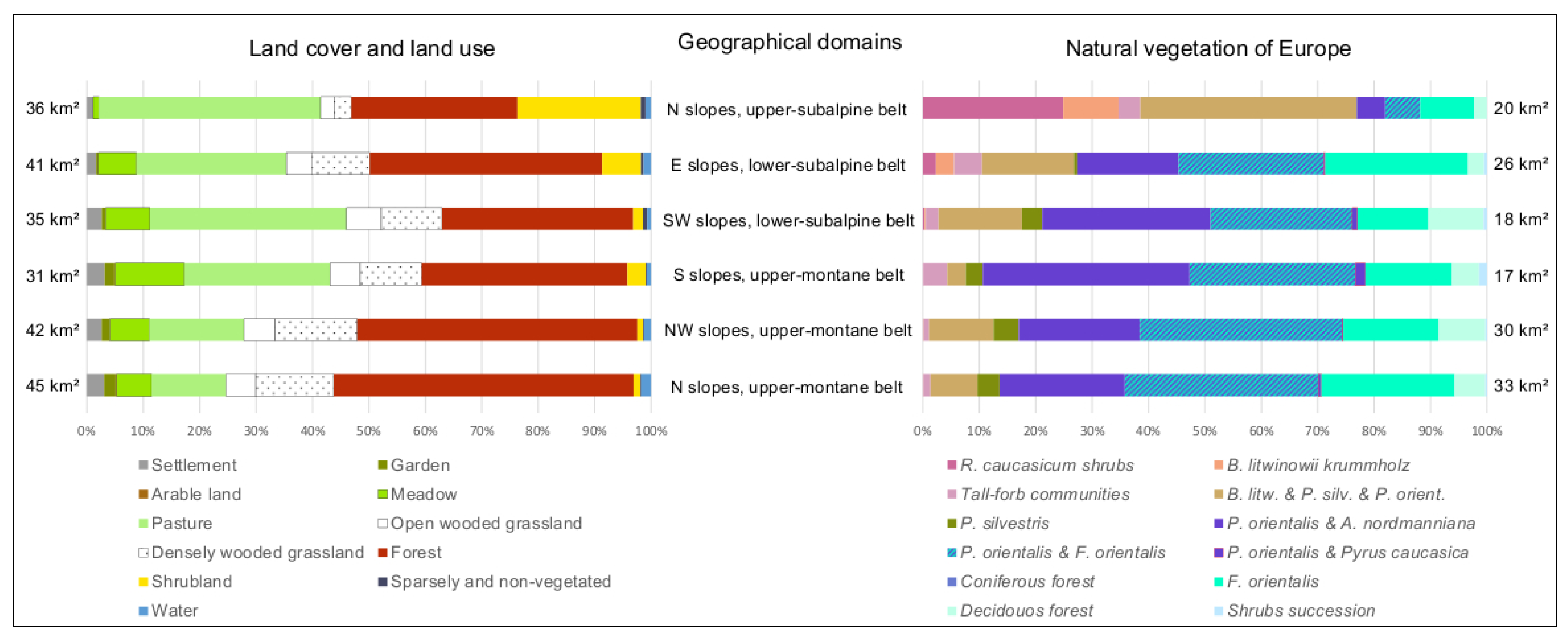High-Mountain Landscape Classification to Analyze Patterns of Land Use and Potential Natural Vegetation
Abstract
:1. Introduction
- -
- What are the patterns in the local land-use and forest distributions?
- -
- To quantify and interpret the high-mountain land-use and forest patterns, how can this be implemented appropriate?
- -
- How natural is the forest in the study area?
- -
- Does a classification of the mountainous landscape help to explain a diverse landscape structure?
2. Study Area
2.1. Geographical Location
2.2. Climate, Geology and Soil
2.3. Land Use in the Tsikhisjvari-Bakuriani Basin
2.4. Agriculture and Forestry during and after the Soviet Period
3. Material and Methods
3.1. Land-Cover and Land Use Mapping
3.2. Data Processing
3.3. Data Analysis
4. Results
4.1. Quantification of the Local Land-Use Pattern
4.2. Interpretation and Quantification of the Local Forest
- -
- Caucasian fir, spruce-fir and beech-fir forests (Abies nordmanniana, Picea orientalis, Fagus sylvatica subsp. orientalis) without evergreen understorey, partly alternating with Oriental beech forests (Fagus sylvatica subsp. orientalis) (BfN-mapping unit D 33).
- -
- Transcaucasian oak forests (Quercus iberica), hornbeam-oak forests (Quercus iberica, Carpinus betulus) and Oriental hornbeam-oak forests (Quercus iberica, Carpinus orientalis), with Acer cappadocicum, Sorbus torminalis, partly in combination with shibliak communities (scrub) (F 170).
- -
- Caucasian Oriental beech forests (Fagus sylvatica subsp. orientalis) with Carpinus betulus, partly with Picea orientalis, without evergreen understorey, partly alternating with oak-hornbeam forests (Carpinus betulus, Quercus iberica) (F 164).
- -
- Southeast and Low Caucasian krummholz and open woodlands (Betula litwinowii, Acer trautvetteri, Quercus macranthera), scrub (Rhododendron caucasicum), tall-forb communities (Heracleum sosnowskyi, Aconitum orientale) and grasslands (Festuca woronowii, Calamagrostis arundinacea, Geranium ibericum) (C 44).
- -
- Caucasian pine forests (Pinus kochiana), partly alternating with birch forests (Betula litwinowii, B. raddeana) and spruce forests (Picea orientalis) (mapping unit D 64).
4.3. Landscape Classification along Topography
5. Discussion
5.1. Land-Use Distribution
5.2. Forest Distribution
5.3. Land-Use and Forest Pattern along Topographical Gradients
6. Conclusions
Author Contributions
Funding
Institutional Review Board Statement
Informed Consent Statement
Data Availability Statement
Acknowledgments
Conflicts of Interest
References
- EU-FAO. Assessment of the Agriculture and Rural Development Sectors in the Eastern Partnership Countries; Georgia (No. FAO Project No. GCP/RER/041/EC); FAO Regional Office for Europe and Central Asia: Budapest, Hungary, 2013. [Google Scholar]
- Nakhutsrishvili, G. The Vegetation of Georgia (South Caucasus); Springer: Berlin/Heidelberg, Germany, 2013. [Google Scholar]
- Volodicheva, N. The Caucasus. In The Physical Geography of Northern Eurasia; Shahgedanova, M., Ed.; Oxford University Press: Oxford, UK; New York, NY, USA, 2002; pp. 350–376. [Google Scholar]
- Nagy, L.; Grabherr, G. The Biology of Alpine Habitats. In The Biology of Habitats Series; Oxford University Press: Oxford, UK; New York, NY, USA, 2009. [Google Scholar]
- Nakhutsrishvili, G. High Mountain Vegetation of the Caucasus Region. In Alpine Biodiversity in Europe; Nagy, L., Grabherr, G., Körner, C., Thompson, D.B.A.E., Eds.; Springer: Berlin/Heidelberg, Germany, 2003; pp. 93–103. [Google Scholar]
- Millennium Ecosystem Assessment. Ecosystems and Human Well-Being: Current State and Trends; Island Press: Washington, DC, USA, 2005; Volume 1. [Google Scholar]
- Krever, V.; Zazanashvili, N.; Jungius, H.; Williams, L.; Petelin, D. (Eds.) Biodiversity of the Caucasus Ecoregion: An Analysis of Biodiversity and Current Threats and Initlal Investment Portfolio; World Wide Fund for Nature: Baku, Azerbaijan, 2001. [Google Scholar]
- Mittermaier, R.A.; Myers, N.; Mittermeier, C. (Eds.) Hotspots: Earth’s Biologically Richest and Most Endangered Terrestrial Ecoregions, 1st ed.; CEMEX and Conservation International: Mexico City, Mexico, 1999. [Google Scholar]
- Myers, N.; Mittermeier, R.A.; Mittermeier, C.G.; Da Fonseca, G.A.; Kent, J. Biodiversity hotspots for conservation priorities. Nature 2000, 403, 853–858. [Google Scholar] [CrossRef] [PubMed]
- Zazanashvili, N.; Sanadiradze, G.; Bukhnikashvili, A. Caucasus. In Hotspots: Earth’s Biologically Richest and Most Endangered Terrestrial Ecoregions; Mittermaier, R.A., Meyers, P., Robles, G., Mittermeier, C.G., Eds.; Conservation International, CEMEX/Agrupacion Sierra Madre: Mexico City, Mexico, 1999; p. 432. [Google Scholar]
- Ministry of Agriculture. Rural Development Strategy of Georgia 2017–2020; Government of Georgia: Tbilisi, Georgia, 2016.
- Zazanashvili, N.; Mallon, D. (Eds.) Status and Protection of Globally Threatened Species in the Caucasus; Contour Ltd.: Tbilisi, Georgia, 2009. [Google Scholar]
- Galvánek, D.; Lepš, J. Changes of species richness pattern in mountain grasslands: Abandonment versus restoration. Biodivers. Conserv. 2008, 17, 3241–3253. [Google Scholar] [CrossRef]
- Akhalkatsi, M.; Ekhvaia, J.; Mosulishvili, M.; Nakhutsrishvili, G.; Abdaladze, O.; Batsatsashvili, K. Reasons and Processes Leading to the Erosion of Crop Genetic Diversity in Mountainous Regions of Georgia. Mt. Res. Dev. 2010, 30, 304–310. [Google Scholar] [CrossRef]
- Nakhutsrishvili, G.; Akhalkatsi, M.; Abdaladze, O. Main threats to mountain biodiversity in Georgia. In Mountain Forum Bulletin; Mountain Forum Secretariat, Ed.; 2009; pp. 18–19. Available online: https://www.researchgate.net/publication/234836466_Main_Threats_to_Mountain_Biodiversity_in_Georgia (accessed on 8 May 2022).
- Kohler, T.; Giger, M.; Hurni, H.; Ott, C.; Wiesmann, U.; Wymann von Dach, S.; Maselli, D. Mountains and Climate Change: A Global Concern. Mt. Res. Dev. 2010, 30, 53–55. [Google Scholar] [CrossRef] [Green Version]
- Kohler, T.; Maselli, D. Mountains and Climate Change: From Understanding to Action; CDE: Bern, Switzerland, 2009. [Google Scholar]
- Briner, S.; Elkin, C.; Huber, R.; Grêt-Regamey, A. Assessing the impacts of economic and climate changes on land-use in mountain regions: A spatial dynamic modeling approach. Agric. Ecosyst. Environ. 2012, 149, 50–63. [Google Scholar] [CrossRef]
- Gentle, P.; Maraseni, T.N. Climate change, poverty and livelihoods: Adaptation practices by rural mountain communities in Nepal. Environ. Sci. Policy 2012, 21, 24–34. [Google Scholar] [CrossRef]
- Bohn, U.; Neuhäusl, R.; Gollub, G.; Hettwer, C.; Neuhäuslová, Z.; Schlüter, H.; Weber, H. Karte der Natürlichen Vegetation Europas/Map of the Natural Vegetation of Europe, Explanatory Text, 1st ed.; Landwirtschaftsverlag: Münster, Germany, 2004. [Google Scholar]
- Horvat, I.; Glavač, V.; Ellenberg, H. Vegetation Südosteuropas-Vegetation of Southeast-Europe, Geobotanica Selecta; G. Fischer: Stuttgart, Germany, 1974. [Google Scholar]
- Kuemmerle, T.; Hostert, P.; Radeloff, V.C.; van der Linden, S.; Perzanowski, K.; Kruhlov, I. Cross-border Comparison of Post-socialist Farmland Abandonment in the Carpathians. Ecosystems 2008, 11, 614–628. [Google Scholar] [CrossRef]
- Heinimann, A.; Breu, T.; Kohler, T. The Challenge of Applying Geographic Information Systems to Sustainable Mountain Development. Mt. Res. Dev. 2003, 23, 312–319. [Google Scholar] [CrossRef] [Green Version]
- Pecher, C.; Tasser, E.; Walde, J.; Tappeiner, U. Typology of Alpine region using spatial-pattern indicators. Ecol. Indic. 2013, 24, 37–47. [Google Scholar] [CrossRef]
- Zimmermann, P.; Tasser, E.; Leitinger, G.; Tappeiner, U. Effects of land-use and land-cover pattern on landscape-scale biodiversity in the European Alps. Agric. Ecosyst. Environ. 2010, 139, 13–22. [Google Scholar] [CrossRef]
- Samtskhe Javakheti Region Map; European Centre for Minority Issues (ECMI): Flensburg, Germany, 2002.
- Metreveli, K. Ensuring Sustainability of Forests and Livelihoods through Improved Governance and Control of Illegal Logging for Economies in Transition (Working Document-Georgia for the World Bank); Company Savcor Indufor, Indufor Oy: Helsinki, Finland, 2005. [Google Scholar]
- Javakhishvili, A.N. Postforest Meadows in der Bakuriani Region (Monography); Botanical Institute of the Academy of Science of the Georgian Soviet Socialist Republic (SSR): Tbilisi, Georgia, 1949. [Google Scholar]
- Kordzakhia, M. Climate of Georgia (Monography); Academy of Science of the Georgian Soviet Socialist Republic (SSR): Tbilissi, Georgia, 1961. [Google Scholar]
- Koronovsky, N. Tectonics and Geology. In The Physical Geography of Northern Eurasia; Oxford University Press: Oxford, UK; New York, NY, USA, 2002; pp. 1–35. [Google Scholar]
- Walter, H. Die Vegetation Osteuropas, Nord- und Zentralasiens. Vegetationsmonographien der Einzelnen Großräume; Gustav Fischer Verlag: Stuttgart, Germany, 1974. [Google Scholar]
- Urushadze, T.; Ghambashidze, G.O. Soil Ressources of Georgia. In Soil Resources of Mediterranean and Caucasus Countries, Scientific and Technical Research Series; Publications Office of the European Union: Luxembourg, 2013; pp. 1–244. [Google Scholar]
- Ministry of Regional Development and Infrastructure of Georgia. Samtskhe-Javakheti Regional Development Strategy 2014–2021; Ministry of Regional Development and Infrastructure of Georgia, Deutsche Gesellschaft für Internationale Zusammenarbeit (GIZ): Tbilisi, Georgia, 2013.
- Wheatley, J. The Integration of National Minorities in the Samtskhe-Javakheti and Kvemo Kartli provinces of Georgia. Eur. Cent. Minor. Issues 2009. [Google Scholar] [CrossRef]
- Heiny, J. Socio-Economic Conditions of Rural Georgian Households and Their Behavioral Intentions Regarding Tourism Development: An Empirical Analysis (Dissertation, Monography); Justus Liebig University Giessen: Giessen, Germany, 2017. [Google Scholar]
- Plachter, H.; Hampicke, U. (Eds.) Nature Conservation Accounting for Large-Scale Livestock Grazing. In Large Scale Livestock Grazing; Springer: Berlin/Heidelberg, Germany, 2010; pp. 439–463. [Google Scholar]
- Didebulidze, A.; Plachter, H. Nature conservation aspects of pastoral farming in Georgia. In Pasture Landscapes and Nature Conservation; Redecker, B., Finck, P., Härdtle, W., Riecken, U., Schröder, E., Eds.; Springer: Berlin/Heidelberg, Germany, 2002; pp. 87–105. [Google Scholar]
- Price, M.F. Cooperation in the European Mountains 2: The Caucasus, 1st ed.; Environmental Research Series; IUCN: Gland, Switzerland; Cambridge, UK, 2000. [Google Scholar]
- Oedl-Wieser, T.; Dax, T.; Fischer, M. A new approach for participative rural development in Georgia–reflecting transfer of knowledge and enhancing innovation in a non-European Union context. Stud. Agric. Econ. 2017, 119, 48–54. [Google Scholar] [CrossRef] [Green Version]
- Heiselmayer, P.; Zazanashvili, N. Subalpine and oro-Mediterranean vegetation (forests, scrub and dwarf shrub communities in combination with grasslands and tall-forb communities). In Karte der Natürlichen Vegetation Europas/Map of the Natural Vegetation of Europe, Explanatory Text; Bohn, U., Ed.; Landwirtschaftsverlag: Münster, Germany, 2004; pp. 154–165. [Google Scholar]
- Hübl, E.; Nakhutsrishvili, G.; Scharfetter, E. Der Weidewald des Alpengartens von Bakuriani (Georgien). Verh. Der Zool.-Bot. Ges. Österr. 2010, 147, 99–108. [Google Scholar]
- Robinson, S.; Milner-Gulland, E.J.; Alimaev, I. Rangeland degradation in Kazakhstan during the Soviet era: Re-examining the evidence. J. Arid Environ. 2003, 53, 419–439. [Google Scholar] [CrossRef] [Green Version]
- Curtis, G.E. (Ed.) Georgia-A Country Study; US Library of Congress, Federal Research Division: Washington, DC, USA, 1994.
- Didebulidze, A.; Urushadze, T. Agriculture and Land Use Change in Georgia. In Georgia in Transition-Experiences and Perspectives; King, L., Khubua, G., Eds.; Peter Lang Internationaler Verlag der Wissenschaften: Giessen, Germany, 2009; pp. 241–264. [Google Scholar]
- Abbott, P.; Wallace, C.; Sapsford, R. Surviving the Transformation: Social Quality in Central Asia and the Caucuses. J. Happiness Stud. 2011, 12, 199–223. [Google Scholar] [CrossRef] [Green Version]
- Salukvadze, J. Land reform and land management in post-Soviet Georgia. Anthropol. East Eur. Rev. 1999, 17, 4–12. [Google Scholar]
- Lohm, H. Dukhobors in Georgia: A Study of the Issue of Land Ownership and Inter-Ethnic Relations in Ninotsminda rayon (Samtskhe-Javakheti); European Centre for Minority Issues (ECMI): Flensburg, Germany, 2006. [Google Scholar]
- Fischer, S.; Gelb, A. The process of socialist economic transformation. J. Econ. Perspect. 1991, 5, 91–105. [Google Scholar] [CrossRef]
- Kötschau, K.; Sepashvili, E.; Narimanidze, N. Agriculture in Georgia-Commercial Sector or Social Safety Net. In Georgia in Transition-Experiences and Perspectives; King, L., Khubua, G., Eds.; Peter Lang Internationaler Verlag der Wissenschaften: Giessen, Germany, 2009; pp. 221–240. [Google Scholar]
- The World Bank. Georgia Poverty Assessment Report (Human Development Sector Unit South Caucasus Country Unit Europe and Central Asia Region No. 44400- GE), Poverty Assessment; The World Bank: Washington, DC, USA, 2009. [Google Scholar]
- Rowland, R.H. National and regional population trends in Georgia, 1989–2002: Results from the 2002 census. Eurasian Geogr. Econ. 2006, 47, 221–242. [Google Scholar] [CrossRef]
- Ministry of Environment and Natural Resources. Forest Code of the Republic of Georgia; Government of Georgia: Tbilisi, Georgia, 1999.
- Waldhardt, R.; Abdaladze, O.; Otte, A.; Simmering, D. Landschaftswandel im Kaukasus Georgiens-Interdisziplinäre Forschung für Eine Nachhaltigere Zukunft (University Publication), Spiegel der Forschung; Justus Liebig University: Giessen, Germany, 2011. [Google Scholar]
- Roberts, D.W. Ordination on the basis of fuzzy set theory. Vegetatio 1986, 66, 123–131. [Google Scholar] [CrossRef]
- Bahrenberg, G.; Giese, E.; Mevenkamp, N.; Nipper, J. Statistische Methoden in der Geographie, 3rd ed.; Gebr. Borntraeger Verlagsbuchhandlung: Berlin, Germany; Stuttgart, Germany, 2008. [Google Scholar]
- StatSoft, Inc. Electronic Statistics Textbook; StatSoft, Inc.: Tulsa, OK, USA, 2013. [Google Scholar]
- Dolukhanov, A.G.; Bohn, U. Caucasian mixed hornbeam-oak forests (Quercus robur, Q. petraea, Q. iberica, Q. pedunculiflora, Q. macranthera, Carpinus betulus, C. orientalis etc.). In Karte Der Natürlichen Vegetation Europas/Map of the Natural Vegetation of Europe, Explanatory Text; Landwirtschaftsverlag: Münster, Germany, 2004; pp. 313–318. [Google Scholar]
- Zazanashvili, N.; Gagnidze, R.; Nakhutsrishvili, G. Main types of vegetation zonation on the mountains of the Caucasus. In Succession and Zonation on Mountains, Particularly on Volcanoes; Sjögren, E., van de Maarel, E., Eds.; Svenska Växtgeografiska sällskapet: Uppsala, Sweden, 2000; pp. 7–16. [Google Scholar]
- Henning, I. Die Dreidimensionale Vegetationsordnung in Kaukasien. In Geology of the High-Mountain Regions of Eurasia, Erdwissenschaftliche Forschung; Franz Steiner Verlag GmbH: Wiesbaden, Germany, 1970; pp. 182–204. [Google Scholar]
- European Environment Agency. Europe’s Ecological Backbone: Recognising the True Value of Our Mountains, EEA Report; Publications Office of the European Union: Luxembourg, 2010.
- European Environment Agency. Europe’s Biodiversity—Biogeographical Regions and Seas. Biogeographical Regions in Europe: The Alpine Region–Mountains of Europe; European Environment Agency: Copenhagen, Denmark, 2002.
- Belonovskaya, E.; Gracheva, R.; Shorkunov, I.; Vinogradova, V. Grasslands of intermontane basins of Central Caucasus: Land use legacies and present-day state. Hacquetia 2016, 15, 37–47. [Google Scholar] [CrossRef] [Green Version]
- Lieskovský, J.; Bezák, P.; Špulerová, J.; Lieskovský, T.; Koleda, P.; Dobrovodská, M.; Bürgi, M.; Gimmi, U. The abandonment of traditional agricultural landscape in Slovakia–Analysis of extent and driving forces. J. Rural Stud. 2015, 37, 75–84. [Google Scholar] [CrossRef]
- Kohler, T.; Elizbarashvili, N.; Meladze, G.; Svanadze, D.; Meessen, H. The Demogeographic Crisis in Racha, Georgia: Depopulation in the Central Caucasus Mountains. Mt. Res. Dev. 2017, 37, 415–424. [Google Scholar] [CrossRef] [Green Version]
- Hartel, T.; Dorresteijn, I.; Klein, C.; Máthé, O.; Moga, C.I.; Öllerer, K.; Roellig, M.; von Wehrden, H.; Fischer, J. Wood-pastures in a traditional rural region of Eastern Europe: Characteristics, management and status. Biol. Conserv. 2013, 166, 267–275. [Google Scholar] [CrossRef]
- Luick, R. Transhumance in Germany; European Forum on Nature Conservation & Pastoralism: Lampeter, UK, 2008. [Google Scholar]
- Bergmeier, E.; Roellig, M. Diversity, threats and conservation of European wood-pastures. In Eurpean Wood-Pastures in Transition—A Social-Ecological Approach; Hartel, T., Plieninger, T., Eds.; Routledge: Abingdon, UK; Oxon, UK, 2014; pp. 19–38. [Google Scholar]
- Buttler, A.; Peringer, A.; Garbarino, M. Ecological patterns and processes at various spatiotemporal scales in wood-pastures of the Swiss Jura Mountains and adaptation to climate change. In Eurpean Wood-Pastures in Transition—A Social-Ecological Approach; Routledge: Abingdon, UK; Oxon, UK, 2014; pp. 90–103. [Google Scholar]
- Gillet, F.; Kohler, F.; Vandenberghe, C.; Buttler, A. Effect of dung deposition on small-scale patch structure and seasonal vegetation dynamics in mountain pastures. Agric. Ecosyst. Environ. 2010, 135, 34–41. [Google Scholar] [CrossRef] [Green Version]
- Mayer, A.C.; Huovinen, C. Silvopastoralism in the Alps: Native plant species selection under different grazing pressure. Ecol. Eng. 2007, 29, 372–381. [Google Scholar] [CrossRef]
- Matuszkiewiez, M. Mesophytic deciduous broad-leaved and mixed coniferous-broad-leaved forests. In Karte der Natürlichen Vegetation Europas/Map of the Natural Vegetation of Europe, Explanatory Text; Landwirtschaftsverlag: Münster, Germany, 2004; pp. 222–228. [Google Scholar]
- Vasilevic, V.I.; Bohn, U.; Zukrigl, K.; Vevle, O.; Wagner, H. Mesophytic and hygromesophytic coniferous and mixed broad-leaved-coniferous forests. In Karte der Natürlichen Vegetation Europas/Map of the Natural Vegetation of Europe, Explanatory Text; Bohn, U., Ed.; Landwirtschaftsverlag: Münster, Germany, 2004; pp. 166–211. [Google Scholar]
- Seifriz, W. Sketches of the Vegetation of Some Southern Provinces of Soviet Russia: III Plant Life in the Bakuriani Basin, Minor Caucasus. J. Ecol. 1932, 20, 53. [Google Scholar] [CrossRef]
- Nakhutsrishvili, G. The Vegetation of Georgia (Caucasus). In Braun-Blanquetia-Review of Geobotanical Monographs, 1st ed.; Institute of Botany-Georgian Academy of Science: Camerino, Italy, 1999. [Google Scholar]
- Zazanashvili, N. Application of the Map of the Natural Vegetation of Europe in Developing a Protected Areas Network in the Caucasus Ecoregion. In Application and Analysis of the Map of the Natural Vegetation of Europe; Bohn, U., Hettwer, C., Gollub, G., Eds.; BfN-Skripten (Bundesamt Für Naturschutz): Bonn, Germany, 2005; pp. 251–262. [Google Scholar]
- Box, O.; Fujiwara, K.; Nakhutsrishvili, G.; Zazanashvili, N.; Liebermann, R.; Miyawaki, A. Vegetation and landscapes of Georgia as a basis for restoration. Bull. Inst. Environ. Sci. Technol. 2000, 26, 69–102. [Google Scholar]
- Ogureeva, G.N. Vegetation Classification for the Map “Zones and altitudinal zonality types of the vegetation of Russia and adjacent territories”. In Application and Analysis of the Map of the Natural Vegetation of Europe; Bohn, U., Hettwer, C., Gollub, G., Eds.; BfN-Skripten (Bundesamt Für Naturschutz): Bonn, Germany, 2005; pp. 113–122. [Google Scholar]
- Holtmeier, F.K. Mountain Timberlines. In Advances in Global Change Research, 2nd ed.; Springer: Dordrecht, The Netherlands, 2009. [Google Scholar]
- Schlüter, H. Comparison of the Potential Natural and Current Vegetation as a Means of Deter-mining its Degree of Naturalness/Vergleich der potentiell-natürlichen mit der heutigen realen Vegetation zur Ableitung ihres Natürlichkeitsgrades. In BApplication and Analysis of the Map of the Natural Vegetation of Europe; Bohn, U., Hettwer, C., Gollub, G., Eds.; BfN-Skripten (Bundesamt Für Naturschutz): Bonn, Germany, 2005; pp. 277–283. [Google Scholar]
- Toscani, P.; Sekot, W. Assessing the Economic Situation of Small-Scale Farm Forestry in Mountain Regions: A Case Study in Austria. Mt. Res. Dev. 2017, 37, 271–280. [Google Scholar] [CrossRef] [Green Version]
- FAO. Global Forest Resources Assessment 2015: How Are the World’s Forests Changing? FAO: Rome, Italy, 2016. [Google Scholar]
- Gratzer, G.; Keeton, W.S. Mountain Forests and Sustainable Development: The Potential for Achieving the United Nations’ 2030 Agenda. Mt. Res. Dev. 2017, 37, 246–253. [Google Scholar] [CrossRef] [Green Version]
- Nakhutsrishvili, G.; Sikharulidze, S.; Abdaladze, O. Bakuriani-Natural and Cultural Ressources of the Borjomi Region; Institute of Botany: Tbilisi, Georgia, 2006. [Google Scholar]





Publisher’s Note: MDPI stays neutral with regard to jurisdictional claims in published maps and institutional affiliations. |
© 2022 by the authors. Licensee MDPI, Basel, Switzerland. This article is an open access article distributed under the terms and conditions of the Creative Commons Attribution (CC BY) license (https://creativecommons.org/licenses/by/4.0/).
Share and Cite
Theissen, T.; Otte, A.; Waldhardt, R. High-Mountain Landscape Classification to Analyze Patterns of Land Use and Potential Natural Vegetation. Land 2022, 11, 1085. https://doi.org/10.3390/land11071085
Theissen T, Otte A, Waldhardt R. High-Mountain Landscape Classification to Analyze Patterns of Land Use and Potential Natural Vegetation. Land. 2022; 11(7):1085. https://doi.org/10.3390/land11071085
Chicago/Turabian StyleTheissen, Tim, Annette Otte, and Rainer Waldhardt. 2022. "High-Mountain Landscape Classification to Analyze Patterns of Land Use and Potential Natural Vegetation" Land 11, no. 7: 1085. https://doi.org/10.3390/land11071085
APA StyleTheissen, T., Otte, A., & Waldhardt, R. (2022). High-Mountain Landscape Classification to Analyze Patterns of Land Use and Potential Natural Vegetation. Land, 11(7), 1085. https://doi.org/10.3390/land11071085




